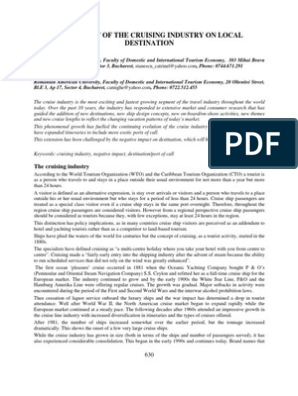0% found this document useful (0 votes)
40 views16 pagesCruise As Part of Water Transport - Development and Challenges
The document discusses the development of cruise tourism as part of water transport. It outlines the beginnings of cruising in the 19th century, characteristics of the modern cruise industry including ship evolution and trends, and statistics showing growth in passengers and destinations. The cruise industry has grown significantly over the past few decades and is projected to continue expanding globally.
Uploaded by
taduranharleydave80Copyright
© © All Rights Reserved
We take content rights seriously. If you suspect this is your content, claim it here.
Available Formats
Download as PDF, TXT or read online on Scribd
0% found this document useful (0 votes)
40 views16 pagesCruise As Part of Water Transport - Development and Challenges
The document discusses the development of cruise tourism as part of water transport. It outlines the beginnings of cruising in the 19th century, characteristics of the modern cruise industry including ship evolution and trends, and statistics showing growth in passengers and destinations. The cruise industry has grown significantly over the past few decades and is projected to continue expanding globally.
Uploaded by
taduranharleydave80Copyright
© © All Rights Reserved
We take content rights seriously. If you suspect this is your content, claim it here.
Available Formats
Download as PDF, TXT or read online on Scribd
/ 16































































































